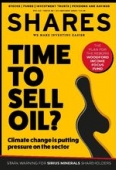Archived article
Please note that tax, investment, pension and ISA rules can change and the information and any views contained in this article may now be inaccurate.
The plan for the reborn Woodford Income Focus fund

Many people in the UK are eagerly waiting to discover what their investment in the Woodford Income Focus (BD9X6V3) fund will look like under the new management of Aberdeen Standard Investments (ASI).
The fund has been suspended since October 2019 and dealing is expected to recommence in the coming weeks under the new name of LF ASI Income Focus.
While the details of the restructured portfolio have yet to be released, the biggest clues we can get in terms of how it may look is by examining two other funds run by ASI, namely Murray Income Trust (MUT) and ASI UK Income Equity (B0XWNB4).
Both of these funds are run by Charles Luke who will also co-manage the Income Focus fund alongside Thomas Moore, fund manager for ASI UK Income Unconstrained Equity (B1LBSV5).
WHAT HAPPENED TO THE FUND?
Woodford ran the Income Focus fund as a concentrated portfolio with about 40 holdings, many of whom were mid to small-cap stocks.
It had suffered from a large number of investor redemptions due to poor performance and concerns about fund manager Neil Woodford’s ability to make them money. Amid the decision to close down Woodford’s asset management business, a new manager was sought for the Income Focus fund and ASI won the pitch.

Murray Income Trust and ASI UK Income Equity have 61 and 76 holdings respectively and their portfolios have a lot of cross-over. Murray differs in that it is an investment trust, borrows money to help widen its investment pool and supercharge returns (known as gearing), as well as having an independent board of directors.
HOW WILL THE WOODFORD FUND CHANGE?
The new version of the Woodford fund will be more concentrated with around 30 holdings, essentially continuing the concentrated approach used by the previous manager.

‘The strategy for Murray and ASI UK Income Equity is to generate a high income, grow that income and deliver capital growth. They have relatively conservative portfolios with a focus on quality companies. We pay a lot of attention to downside protection, resilience and capital preservation,’ says Luke.
‘The Income Focus fund will have a highly concentrated portfolio of the ASI UK team’s best income ideas. We will still be seeking income and capital growth and an attractive dividend yield.
‘We will harness the research insight from the 16-strong ASI UK team which we think is industry-leading. The number of holdings will be less that Murray and ASI UK Income Equity but we still feel 30 stocks provide significant diversification.’
HINTS ABOUT PORTFOLIO STRUCTURE
One of the key criticisms of Woodford’s various funds was liquidity, namely that the manager was investing in too many stocks that would be hard to sell quickly. The Woodford Income Focus fund also came under fire for being too focused on certain sectors.
‘We will run the Income Focus fund as a concentrated version of our strategy,’ says Luke, adding that he and Moore are still in the process of selling some holdings from the inherited portfolio and making new investments, and so he refuses to disclose names until the portfolio has been fully reshaped to their liking.
It is likely to focus on the FTSE 350 index where stocks are more liquid.
‘You can be concentrated and diversified at the same time. We are not being hostage to any one economic scenario, we won’t have 20% of the portfolio in UK housebuilders; rather we’ll have a range of ideas so there isn’t one particular factor that we are depending on.’
Having fewer holdings in the revised Income Focus fund compared to Murray and ASI UK Income Equity effectively means the managers are taking bigger bets on a smaller pool of companies.
Theoretically if they pick the right stocks, individual share price gains will have a greater impact on the overall fund performance than a portfolio with significantly more holdings. The opposite applies where the manager and investors will feel a greater amount of pain if the wrong stocks are picked.
‘Murray and the sister open-ended fund try to outperform with low volatility (up and down swings in price) and being risk-averse.
‘The Income Focus fund will potentially have greater long-term outperformance but a little bit more volatility,’ says Luke.
TEAM BENEFITS
ASI’s ‘significant resources’ were highlighted by fund administrator Link Asset Services in a recent letter to Woodford investors announcing the new manager. Having a strong team to research the market is an advantage to all fund managers as it means they aren’t overstretched trying to do everything themselves.
The 16 managers in the ASI UK team (including Luke and Moore) have live recommendations on every stock in the FTSE 350 index. As part of the research a lot of emphasis is put on ESG factors.
They then create something called a ‘winners list’ which is the top 20 ideas of the UK team. These are stocks where the managers see the highest potential for outperformance.
For Murray and ASI UK Income Equity, Luke then goes through the ideas and looks for quality companies and income opportunities. ‘We have a scoring system which goes from Q1 to Q5, which runs respectively from best to worst. I will only invest in something with a Q1 to Q3 rating.’
WHAT’S IN MURRAY’S PORTFOLIO?
Murray’s portfolio includes pharmaceutical group GlaxoSmithKline (GSK), wealth manager Close Brothers (CBG), life insurer Prudential (PRU) and miner Rio Tinto (RIO) and it currently yields 3.8%. The approach is long-term buy and hold.
New additions in the financial year to 30 June 2019 included building materials group Marshalls (MSLH), Germany-focused Sirius Real Estate (SRE) and utility group SSE (SSE).
Murray’s performance has been good with a top quartile ranking over one, three and five years, according to FE Fundinfo.

One might have expected a quality tilt to have struggled since last summer when the value investment style started to come back into fashion, but Luke says that Murray still outperformed the market in October, November and December.
The fund manager says it can be hard to find lots of companies which are good quality and which pay a good yield so he writes some options to help provide additional income. However, he does point out that ASI’s large research team means the asset manager is still capable of finding interesting ideas which many other people might have missed.
For example, car retailer Inchcape (INCH) is currently part of the portfolio despite the company operating in a struggling sector. ‘We think the market doesn’t appreciate its quality characteristics. The distribution division makes high margins and has long-term relationships. It is trading on 12 times earnings and has a generous dividend yield,’ says Luke.
He also gives the example of wound care specialist Convatec (CTEC) which disappointed the market in the first few years after floating in 2016. Luke believes it suffered from poor management who over-promised. ‘It has a very strong market position and now has a new management team.’
JURY STILL OUT
The investment trust hasn’t been immune to bad decisions and it suffered from holding Saga (SAGA) which was removed from the portfolio after a bad profit warning.
‘Unfortunately we had misjudged the strength of the company’s brand and its resonance with its customer base and also the impact of the highly competitive and commoditised nature of the UK insurance market,’ wrote the trust in its annual report.
Fund managers rarely get everything right; such is the way with investing. However, investors who were burned by holding the Woodford Income Focus fund – with a near-25% negative total return since launch in 2017 – will understandably be nervous, even with a new manager at the helm.
MURRAY INCOME TRUST: QUALITY CHARACTERISTICS
The accompanying table shows Murray’s portfolio quality characteristics compared to the benchmark index, the FTSE All-Share. ‘The price-to-earnings ratio is only marginally more expensive than the benchmark,’ says Luke. ‘We are getting really good quality companies but we aren’t paying over the odds.’

ASI’s qualities would suggest investors are now in good hands, but the jury is still out until the fund has revealed the new-look portfolio and the co-managers can prove their approach works with positive performance data.
Important information:
These articles are provided by Shares magazine which is published by AJ Bell Media, a part of AJ Bell. Shares is not written by AJ Bell.
Shares is provided for your general information and use and is not a personal recommendation to invest. It is not intended to be relied upon by you in making or not making any investment decisions. The investments referred to in these articles will not be suitable for all investors. If in doubt please seek appropriate independent financial advice.
Investors acting on the information in these articles do so at their own risk and AJ Bell Media and its staff do not accept liability for losses suffered by investors as a result of their investment decisions.

 magazine
magazine








